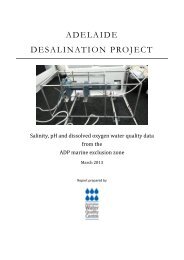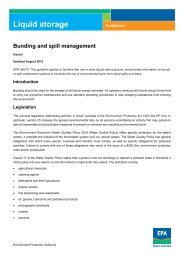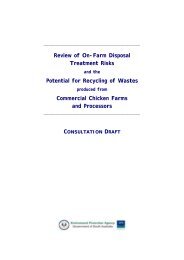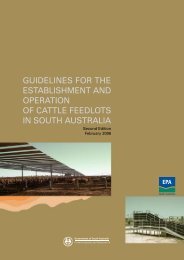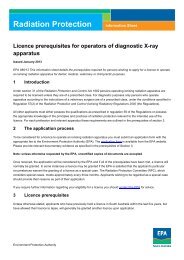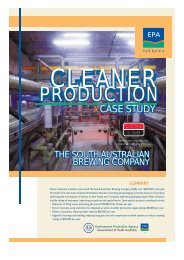2 Renmark to border LAP area assessment - EPA - Sa.gov.au
2 Renmark to border LAP area assessment - EPA - Sa.gov.au
2 Renmark to border LAP area assessment - EPA - Sa.gov.au
You also want an ePaper? Increase the reach of your titles
YUMPU automatically turns print PDFs into web optimized ePapers that Google loves.
River Murray and Lower Lakes catchment risk <strong>assessment</strong> for water quality: Results and management options<br />
Slipways<br />
Risk level: low–moderate<br />
Possible options: capital works, compliance<br />
Suggested lead stakeholders: local councils, <strong>EPA</strong>, BIASA, boating industry<br />
Slipways were rated a moderate risk from wash-off of sediment, heavy metals and pesticides (found in<br />
some antifouling paints). Slipways are currently not inspected nor <strong>au</strong>dited on a regular basis. It is likely<br />
that the majority of slipways along the river are required <strong>to</strong> be licensed by the <strong>EPA</strong> but this has not been<br />
undertaken <strong>to</strong> date.<br />
Management option 29 The <strong>EPA</strong> <strong>to</strong> <strong>au</strong>dit slipways (and license those captured by the<br />
Environment Protection Act 1993 Schedule 1 definition) <strong>to</strong> ensure<br />
compliance with the new Code of Practice for Vessel and<br />
Facility Management: Marine and Inland Waters.<br />
242<br />
Status of implementation: In planning<br />
Uncertainties in the risk <strong>assessment</strong>: No moni<strong>to</strong>ring data on slipway runoff or its effects was obtained<br />
leaving some uncertainty as <strong>to</strong> the risk level.<br />
Wetlands/lagoons<br />
Typical risk level: low–moderate<br />
Possible options: moni<strong>to</strong>ring, research and development<br />
Suggested lead stakeholders: SAMDB NRMB, <strong>EPA</strong>, DWLBC, DEH, SA Water<br />
Wetlands were identified as a low <strong>to</strong> moderate risk <strong>to</strong> water quality. Given that wetlands are a natural<br />
and intrinsically important part of the river ecosystem, they are not a ‘risk’ in the conventional sense.<br />
Many different types of wetlands exist along the river (see the River Murray wetland baseline survey and<br />
Thompson 1986 for more detail on individual wetland characteristics). In general the wetlands present<br />
<strong>to</strong>day are typically not the type or form of wetlands along the River Murray channel before the ‘locking<br />
of the river’ and other activities like irrigation drainage discharges. A number of ephemeral floodplain/<br />
wetland <strong>area</strong>s (eg Chowilla) have been affected by salt and other pollutants which build up over time<br />
without natural flushing. These types of wetlands may release salt and contaminants during artificial<br />
flushing practices or following large localised rainfall events. However, when the river floods, nutrient<br />
and other contaminant concentrations in wetlands are generally diluted (AWQC 1993). Wetland<br />
management should be focused on reducing inputs of contaminants from wetland catchments and<br />
ensuring artificial flushing strategies are properly managed <strong>to</strong> minimise any effects on river water quality<br />
or raw water off-takes. Grazing is also an issue around some wetlands.<br />
Uncertainties in the risk <strong>assessment</strong>: No data was obtained for water quality exiting wetlands as a<br />
result of localised s<strong>to</strong>rm events or artificial flushing. Some ambient water quality data has recently<br />
been collected during the River Murray baseline wetland survey.




